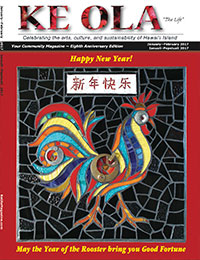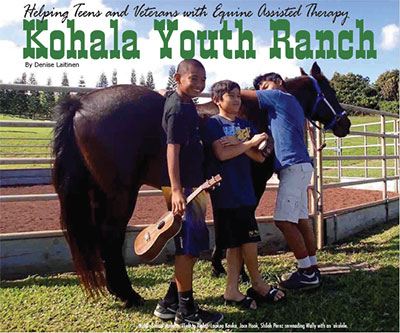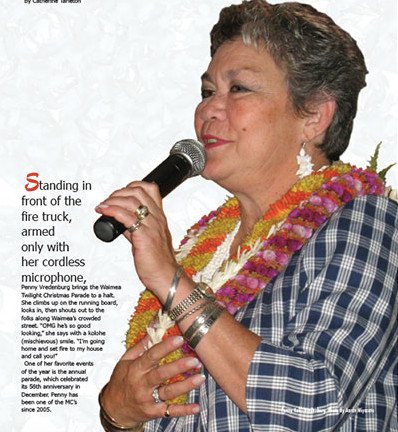Fred Keakaokalani Cachola
 Fred Keakaokalani Cachola was born at a time when Hawai‘i was still a territory, graduating from Kamehameha Schools in 1953, six years before Hawai‘i became the 50th state. He was in the U.S. Army, yet remained a Hawaiian in every sense of the word. Back then, when electricity did not reach most of Hawai‘i Island, his family lived a simple life in Kohala. Fred reflects this rural lifestyle, and has never shed his “kua‘āina kid” roots, like picking fruit on the side of the road and cooking it to store for the winter months.
Fred Keakaokalani Cachola was born at a time when Hawai‘i was still a territory, graduating from Kamehameha Schools in 1953, six years before Hawai‘i became the 50th state. He was in the U.S. Army, yet remained a Hawaiian in every sense of the word. Back then, when electricity did not reach most of Hawai‘i Island, his family lived a simple life in Kohala. Fred reflects this rural lifestyle, and has never shed his “kua‘āina kid” roots, like picking fruit on the side of the road and cooking it to store for the winter months.
As he stands at the gas stove and stirs his guava jam (picked from up Kohala Mountain Road), he gleefully sings, “You’ll Never Find Another Hawaiian Like Me”, as we all enjoy his charm, hospitality, and true aloha. “We Hawaiians, we share!” he says. “Come, try some!”

At heart, Fred is warm and compassionate, as he expresses his love for Queen Lili‘uokalani for all she did for him by leaving behind a trust for Hawaiian children. “If it wasn’t for her, I don’t know what would have happened to my family,” he recalls. Fred lost his mother, Esther U‘u, when he was only eight years old, leaving behind her husband, Fredrico Laya Cachola, Sr. to raise the children.
He recalls how some of his siblings were almost separated, yet with the Queen’s Trust, they made it through. Fred also speaks fondly of Princess Bernice Pauahi Bishop, for leaving behind a legacy that has touched his life so deeply. “I always say I have two aunties: ‘Aunty Lili‘u and Aunty Bernice,’ because they both made me who I am today. The Queen for her help with my family and the education I received from the Princess,” he says. Both Hawaiian monarchs were strong, independent women who wanted to make sure their fortunes and land were used for the people of Hawai‘i, particularly the orphaned and indigent children like Fred once was.
The Queen Lili‘uokalani Trust cares for the immediate needs of the orphaned child and their family, and Kamehameha Schools, Fred’s alma mater, was created by the Princess to make sure Hawaiian children have an education. Fred is thankful he was a recipient of both monarchs’ benevolence, and he never forgot it.
Today, his blood runs deep with devotion to his Hawaiian heritage and the legacy he has built all these years from hard work and perseverance, on a mission to create a better world for all children.
From his days of living as a simple Kohala country boy, to his auspicious career as an educator and cultural historian, Fred has always kept the values he learned as a keiki o ka ‘āina, a child of the land. The value of mālama, to take care, is what he has done for his family and the people of Hawai‘i all his adult life, and he does this to give back for what was given to him. In the 60s, he ended his time in the military and began his career as a teacher after graduating from Iowa State Teacher’s College. He taught at Wai‘anae Intermediate, then vice principal of Nānākuli High School and later, principal of Nānāikapono Elementary, making his home on the West Side for 30 years—and he loved it. He started a program there to transform the school into a center for learning, bringing in community members to share their knowledge of the area and its history.
“There was a time when the kūpuna knew all the kids. What I saw in Wai‘anae were teachers who were coming in from places outside of the area to teach. They did not really understand where the kids were coming from and what they went through at home. All they looked at were test scores. I saw myself in some of those kids. The public school system is very competitive, and Hawaiian students, in particular, were not doing well like that. We did a school-based study at the time to show this: we had these students study for their standardized tests individually and in groups. And guess what? Those students who did better were the ones in the groups. It showed that they were more collaborative, group thinkers, and that relationships really mattered in their success,” Fred recalls. Through time, he also made sure the teachers got to know the students and he arranged it so that they would be required to spend time on their short day, Wednesdays, to make off-campus visits with their students, either at their home or somewhere in the community. That way, they could get to know students better and be able to teach them from where they were at. “I wanted to show that the school should reflect the values and beliefs of its students and where they live. I brought the community onto the campus, and we showed the students that we want to serve them and value what is important to them,” he says. “We made the campus central to their lives, and it worked!”
This was followed by an offer in 1971 to be the first Director of Extension Education at Kamehameha Schools. He accepted and began transformational changes that are still felt and appreciated today by many. One was the institution of Hawaiian language classes as mandatory for every student in order to graduate. As he looked at the school’s curriculum, he saw that Hawaiian was just another foreign language elective, while the R.O.T.C. military training program was mandatory. Being alumni, he had no qualms with the program, except that Hawaiian language was far more important, in his opinion, for a Hawaiian school like Kamehameha. Eventually, the R.O.T.C. classes became electives, and now every student must take Hawaiian language in high school.
Going beyond Kamehameha Schools, Fred has also participated in numerous community initiatives, such as the creation of the Protect Kaho‘olawe ‘Ōhana (PKO) in the 70s, when sovereignty was a new word in Hawaiian circles.
“I helped create PKO with George Helm because I truly believed, deep in my heart, that this land is so sacred. When I went to Kaho‘olawe, it took me to another level. We have been protecting and taking care of this island for many, many years now, and are proud of our efforts to restore this ‘āina,” he says.
Fred even authored the resolution to designate Kamehameha’s birthstone in Kohala as a state monument, and was a member of the Advisory Commission (1972-74) which helped to established the Kaloko-Honokōhau National Historic Park by Congress in 1978. He also tells a story of how his daughters, now adults with their own families, became a part of it all.
“I can never forget when I rediscovered Hale o Ka‘ili, the first heiau Kamehameha dedicated to his family war god, Kuka‘ilimoku, around 1779-80. It was on a cliff in Hapu‘u, Kohala. I felt it there, and I tried to walk over to it. I went 40 paces, then I saw it: but I couldn’t get near it. I couldn’t pass a certain spot. This went on for years. I went, I tried to approach it, but I am stopped and cannot go forward at a certain point. I visited this site for six years, and on the seventh year, something changed and I was able to go all the way up to it. My daughters were with me, and we saw two large stones many feet apart, as if in a straight line. So I had each stand at opposite sides and walk towards each other. That’s how we figured out it was a straight line, and how it might have looked in the past. It was built in 1778 by Kamehameha I when he was made custodian of Kūkā‘ili-moku,” says Fred.
Fred was recently a delegate for Na‘i Aupuni, a group supported by the Office of Hawaiian Affairs which allows for Hawaiians to form a government and constitution. “I was on the Preamble committee, in which we looked at the proposed constitution for the new government. We collectively agreed and presented to the rest of the delegates that we believed that Hawaiians have spoken and we must respect their wishes. If the majority don’t want a nation-to-nation relationship with the United States, we must honor that. We fought long and hard for the one line statement that says we will not relinquish our right to complete independence.
Fred found the interest in civic politics from the younger generation refreshing. “I would say 50 percent of that group (Na‘i Aupuni) was under 40. It made me feel good that there were young people that could stand up and articulate their mana‘o (thoughts),” he says. “The young, articulate Hawaiians, what a joy.”
As the 2005 recipient of the Order of Ke Ali‘i Pauahi award for his lifetime of service to the Hawaiian community, he has much to share with the younger generation. “Understanding who you are is the first thing. You cannot move forward if you don’t know who you are and what your responsibility is to the ‘āina and to the people. To the younger ones who are fighting for issues like Mauna Kea, I would say that if we bring out our guns and grenades, then we simply assimilated to the western mentality of violence. We have got to use aloha as our weapon. Have a sense of ‘āina and truly care about what you do. Restore the dignity of the Hawaiian people in sincerity, and use the Hawaiian language to express it. Make sure we are reaching back while we reach forward, never losing our sense of being a Hawaiian. When I was first introduced to politics back in the 70s, I saw no Hawaiians—Democrat or Republican! So I created what we called, the ‘Homerule Movement,’ where we began educating them to become more actively involved and benefit from politics,” he says. “That is how it’s going to happen.”
Now, Fred’s children are a large part of his legacy. His daughter, Julie-Ann holds a master’s degree in urban and regional planning, working for the Department of Hawaiian Homelands, while his middle daughter, Leinani, holds a bachelor’s in botany and works for a pharmaceutical company. Youngest of the three, Kehau, holds a doctorate in anthropology and archaeology from the University of Hawai‘i (the first Hawaiian ever to receive a PhD in this field). “I’m very proud of my girls,” he says.
Fred has also established the Ho‘okama Scholarship for deserving college students, funded by the Cachola family. He is a kupuna on the move, an island treasure who has done much to shake up the local community for the good. It was an honor to talk story with Fred Cachola, Kohala’s “kua‘āina kid.” ◊
Contact photographer Adam Prall: adamprall@thinkingman.com
Contact writer and Shana Wailana Logan: Slogan808@gmail.com


